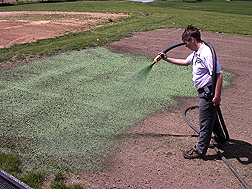Cotton Bests Other Spray-On Erosion-Control Mulches
|
|
Agricultural Research Service agricultural engineer Greg Holt helped develop the erosion-control industry’s first cotton byproduct hydromulch “spray-on blanket.”
Developed in cooperation with Cotton Incorporated of Cary, North Carolina, and Mulch & Seed Innovations of Centre, Alabama, GeoSkin Cotton Byproduct Hydromulch is made from cotton gin byproducts.
Hydromulch is the name for the bright-green slurry sprayed on bare land at construction sites and roadside projects to prevent erosion until vegetation can be established. Hydromulches are typically made from wood or paper byproducts or a blend of the two. Commercial roll-on blankets made of straw, wood, or coconut are also used to control erosion.
The cotton byproduct hydromulch is a combination of a hydromulch and an erosion-control blanket. In tests by Holt, it controlled erosion better than conventional roll-on blankets and required significantly less labor.
In tests of four types of mulches, total runoff—which included soil and mulch ingredients—was 7,832 pounds per acre from straw; 7,474 pounds per acre from wood; 3,719 pounds per acre from coconut; but just 222 pounds per acre from the cotton byproduct hydromulch.
The cotton byproduct hydromulch spray-on blanket was produced by a mechanical process known as the “cross-linked biofiber process.” It was developed from the cooperative research efforts of ARS, Cotton Incorporated, Summit Seed Incorporated of Manteno, Illinois, and Mulch & Seed Innovations. ARS has applied for a patent on the process.
Previously, Holt had used the ARS-patented Cotton Byproducts (COBY) process as a low-cost way to develop cotton waste into products such as hydromulches.
The new technology has served as a foundation for developing a broader line of cotton byproduct hydromulches for erosion control, including a premium hydromulch for steep slopes, and more recently, a midgrade product for flat- to midslope terrain.
Holt conducted a study in which cotton-based hydromulches established a good stand of grass. Other hydromulches and a straw erosion-control blanket did not do as well.
Holt is at the ARS Cotton Production and Processing Research Unit in Lubbock, Texas. Cotton Incorporated, funded by U.S. growers of upland cotton and importers of cotton and cotton textile products, is the research and marketing organization representing upland cotton. The organization partly funded some of Holt’s studies, which also involved farm consultant Brent Busenlehner; ARS colleague Ken Potter in Temple, Texas; and Elizabeth Guertal, a professor at the Department of Agronomy and Soils, within Auburn University’s College of Agriculture.
“Development of this cotton byproduct hydromulch is part of ARS’s overall efforts to convert cotton waste from a financial liability to a revenue stream,” Holt says. “The financial liability includes the costs of disposal or combustion of the gin-waste pile. Cotton gin byproducts are actually a valuable resource whose nitrogen-phosphorus-potassium content and porous, absorbent, and biodegradable structure are ideal characteristics for a seed starter.”—By Don Comis, Agricultural Research Service Information Staff.

This research is part of Quality and Utilization of Agricultural Products, an ARS national program (#306) described on the World Wide Web at www.nps.ars.usda.gov.
Gregory A. Holt is in the USDA-ARS Cotton Production and Processing Research Unit, 1604 E. FM 1294, Lubbock, TX 79403; phone (806) 746-5353, fax (806) 746-5028.
"Cotton Bests Other Spray-On Erosion-Control Mulches" was published in the May/June 2009 issue of Agricultural Research magazine.







